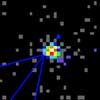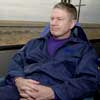|
Sunday:
November 5, 2000 | |
0511 GMT |  |
Chandra captures telling gamma-ray afterglow
The Chandra Observatory's sharp-eyed X-ray vision has detected something never before seen. The discovery may help find the origin of what many researchers believe are the most powerful explosions in the Universe.
 FULL STORY FULL STORY
 |  |

|  |
DAILY BRIEFING Other stories making news today
|  |
Universities launch Astrobiology center -- Cardiff University is to become home to the UK's first Centre for Astrobiology -- providing the UK with a facility to contribute to space missions probing for life on solar system bodies. It forges a connection between astronomy and biology.
|
 |
|
Saturday:
November 4, 2000 | |
0809 GMT |  |
Space object found that could hit Earth in 2030
Astronomers have found a very small asteroid-like object with a 1-in-500 chance of impacting the Earth in 2030. The unusual orbit of the object suggests it might not be a asteroid but possibly a spent stage from an Apollo moon mission.
 FULL STORY FULL STORY
 |  |

|  |
Station crew complains of grueling schedule
Despite complaints by space station skipper William Shepherd early Friday about the crew's heavy workload, a senior NASA flight director says the schedule will improve within a week or so as equipment gets stored and critical life support systems are activated.
 FULL STORY FULL STORY
 |  |

|

|
 |
 |
 |


Hubble poster
 The Hubble Space Telescope's majestic view of the Eskimo Nebula. This spectacular poster is available now from the Astronomy Now Store.
The Hubble Space Telescope's majestic view of the Eskimo Nebula. This spectacular poster is available now from the Astronomy Now Store.
MORE

Earlier news
Oct. 23-29: Discovery lands in California; Four new moons found orbiting Saturn; Strange shapes on the sizzling world of volcanic Io; Revealing Neptune's icy atmosphere, Uranus' rings; 100th Ariane 4 launch.

Oct. 16-22: Space station construction mission successful; Gigantic gamma-ray burst breaks all distance records; New light shed on Milky Way's elusive center; Atlas, Proton and Sea Launch rocket missions.

Oct. 9-15: Astronauts lend hand building space station; Dust disk found around a nearby star and planet; Hubble finds a tantalizing veil from exploded star; Pegasus rocket launches NASA science probe.

Oct. 2-8: Lonely giant planets seen 1,000 light years away; 100th shuttle launch delayed; Data relay glitch threatens mission to Saturn moon; Future of Mir uncertain; Proton and Ariane 4 launches.

More news See our weekly archive of space news.

Contact us
If you have a comment or question for Spaceflight Now, just send us an e-mail.


|


 The Hubble Space Telescope's majestic view of the Eskimo Nebula. This spectacular poster is available now from the Astronomy Now Store.
The Hubble Space Telescope's majestic view of the Eskimo Nebula. This spectacular poster is available now from the Astronomy Now Store.